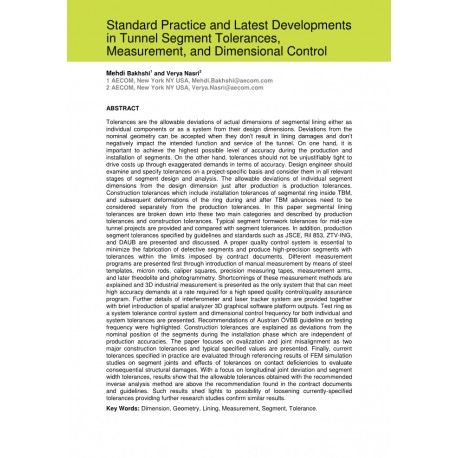Cart
0
0
No document
0,00 €
Total
Document successfully added to your shopping cart
Quantity
Total
There are 0 items in your cart.
There is 1 item in your cart.
Total documents
Total shipping
To be determined
Total
Search & filter
Search for a publication
Search & filter

Standard Practice and Latest Developments in Tunnel Segment Tolerances, Measurement, and Dimensional Control
2225_standard_practice_and_lates
Tolerances are the allowable deviations of actual dimensions of segmental lining either as individual components or as a system from their design dimensions. Deviations from the nominal geometry can be accepted when they don’t result in lining damages and don’t negatively impact the intended function and service of the tunnel. On one hand, it is important to achieve the highest possible level of accuracy during the production and installation of segments. On the other hand, tolerances should not be unjustifiably tight to drive costs up through exaggerated demands in terms of accuracy. Design engineer should examine and specify tolerances on a project-specific basis and consider them in all relevant stages of segment design and analysis. The allowable deviations of individual segment dimensions from the design dimension just after production is production tolerances. Construction tolerances which include installation tolerances of segmental ring inside TBM, and subsequent deformations of the ring during and after TBM advances need to be considered separately from the production tolerances. In this paper segmental lining tolerances are broken down into these two main categories and described by production tolerances and construction tolerances. Typical segment formwork tolerances for mid-size tunnel projects are provided and compared with segment tolerances. In addition, production segment tolerances specified by guidelines and standards such as JSCE, Ril 853, ZTV-ING, and DAUB are presented and discussed. A proper quality control system is essential to minimize the fabrication of defective segments and produce high-precision segments with tolerances within the limits imposed by contract documents. Different measurement programs are presented first through introduction of manual measurement by means of steel templates, micron rods, caliper squares, precision measuring tapes, measurement arms, and later theodolite and photogrammetry. Shortcomings of these measurement methods are explained and 3D industrial measurement is presented as the only system that that can meet high accuracy demands at a rate required for a high speed quality control/quality assurance program. Further details of interferometer and laser tracker system are provided together with brief introduction of spatial analyzer 3D graphical software platform outputs. Test ring as a system tolerance control system and dimensional control frequency for both individual and system tolerances are presented. Recommendations of Austrian ÖVBB guideline on testing frequency were highlighted. Construction tolerances are explained as deviations from the nominal position of the segments during the installation phase which are independent of production accuracies.


